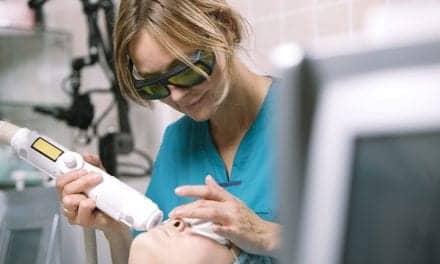
Tissue-engineered skin substitutes can be created from a single biopsy of not more than a few square inches, and then grown in as little as a month.
By David H. Ahrenholz, MD
One hundred fifty years ago, a third-degree burn covering just 10% of the body was 100% lethal. The science and the treatment simply didn’t exist to replace severely burned tissue before infection took over. During and after World War II, however, skin grafting entered the fray, and by the 1980s, cultured epidermis products were introduced to the market. Suddenly, the treatment of large and severe burns became much more feasible, and today the mortality rate for these conditions is less than 5% in the developed world.
This momentum is certainly positive for burn surgeons everywhere, but the industry has almost plateaued. Split-thickness skin grafting, first used in the 1940s, is still the approved treatment for large and severe burns today, and skin substitute products, first introduced 25 years ago, are present in the operating room, though they are expensive and difficult to use. There has not been a commercially available solution that functions like an autologous skin graft, while eliminating the need for multiple harvests from a single donor site, until now.
It’s possible to engineer large quantities of a patient’s own skin—from their own cells—in less time than it takes for a single harvest site to heal. Unlike many of the synthetic or single-layer skin substitutes available today, Amarantus BioScience’s Engineered Skin Substitute (ESS) could be a game-changer for the treatment of large burns. The technology allows cultured epithelial cells to grow on a matrix that is similar to the inner layer of skin. The composite structure, the inner dermis layer with the epidermal layer, are then transplanted together.
The Way Forward
Autologous skin grafts have widely been used for the treatment of large burn cases mainly because risk of rejection is relatively low when using a patient’s own skin to replace burned tissue. But this therapy is not without its limits. When a patient has third-degree burns covering a majority of their body, surgeons are left with little choice than to harvest what living skin is left—over and over again—until the burns are covered and healed. It’s not uncommon for a treatment like this to take months or even years to complete. Patients are highly susceptible to infection, sepsis, or disease during treatment, which is why the mortality rates continue to stay unnecessarily high for this population.
Moreover, donor sites take time to heal, and the health of the skin is reduced as grafting continues. It’s a painful and vicious cycle that yields diminishing results. Imagine six, 10, or even 12 operations on the same part of the body. Skin quality is affected after each procedure, but it also takes longer to heal afterward. The process gets more painful as time goes on. Pediatric cases are even more challenging, since growing children need to continue receiving new skin grafts as their body matures—often for years after an injury.
Tissue-engineered skin substitutes can be created from a single biopsy of not more than a few square inches, and then grown in as little as a month. What patients receive is their own skin in quantities much larger than what could safely be harvested. It grows with patients, eliminating the need for ongoing surgeries. With ESS, the risk of infection and rejection are reduced, and the suffering that’s associated with burn care is diminished.
The economics are affected, too. Large and severe burn cases take months or years to complete. It’s not difficult to understand the financial benefits of fewer operations and less time in a burn center, both for patients and for hospital systems. And burn care is just the beginning. Dermatological conditions like Congenital Hairy Nevus have been treated with ESS. Cosmetic or reconstructive surgeons suddenly have an off-the-shelf solution to produce new skin for patients.
Changing the Standard of Care
ESS is finally on its way to commercialization with upcoming phase 2 US Food and Drug Administration trials and a research agreement with the US Army.
It’s time to once again reduce burn-related mortalities with a better and more humane treatment. The next standard of care for severe burns needs to be growing patients’ own skin in less time and with less pain than with skin grafting. Ultimately, a solution like ESS would improve the standard of care for patients with near-full-body burns while saving time and hospital resources, too.





I’ve been tracking AMarantus for awhile and own shares. I bought more on the way down over the last few months. If anyone wants an investment or a flier and understands what they have, take a closer look. You may be able to make a good deal directly with them for helping to Capitalize efforts. Or in the open market, the shares are priced well. Stock recently bottomed out due to some struggling finances in the R and D stages along with being an over the counter stock. That said, as of Dec 1, it has a market cap of about 5 to 8 million and owns rights to not only Ess but a few other great compounds. Science officer used to be at NIH and discovered MANF…looks to be a key compound around rescuing cells under stress. An add drug is another asset. They’ve done a great job finding compounds and securing rights. Invited to visit China for potential partners too. Think of them as a VC for vetted compounds with some reasonably close to market. There is a diagnostic unit that may spin off and if it does will surely be worth multiples of current market cap. Plz share with friends. Would be cool if a bunch of docs got to reap the benefit of getting this to market. John Haughton MD, MS.
Amarantus Bioscience is currently trading on the O.T.C. market under the trading symbol AMBS.It is quite likely that it will move to the NASDAQ early in 2016.
I have been following the company for more than two years and I think that the current low share price represents a tremendous investment opportunity considering the assets which are in the company’s pipeline.
Stratatech was recently awarded a $247 million contract with the U.S. Department of Health and Human Services’ Biomedical Advanced Research and Development Authority (BARDA) to develop its skin replacement product for severe burns which I believe is inferior to ESS. I think it’s only a matter of time before Amarantus is awarded a similar contract.
The company’s C.E.O. is traveling to China next week as a guest of the Bank of China to meet with potential partners and investors.
Take the time to research the company and I think you’ll see the tremendous potential that it offers.